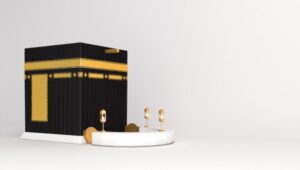
Makkah, the birthplace of the Allah’s Messenger Prophet Mohammad (ﷺ) and home to one of Islam’s holiest sites, is located in central-western Arabia; the Holy Kabah. The Kabah refers to the Masjid-E-Haram, a cubical building in the heart of Makkah’s sanctuary that has been a key place of pilgrimage for all Muslims since the Prophet’s time.
If you want to visit both sanctified places, then Muslims Holy Travel will provide you this great opportunity to turn your dream to be there into reality. You can do so by booking one of the best-selling and affordable 21 Nights Smart, Hassle-Free & Cheap Umrah Packages 2021-2022 with lots of amenities. But first, you should have comprehensive knowledge about every aspect of these sacred attractions, so let’s take a brief overview before booking your journey;
Holy Kabah – The Allah’s House:
The structure of the Sacred Kabah predates the religion Islam’s arrival. According to Muslim belief, Prophet Ibrahim (AS) and his son Ismail (AS) were the first to construct the Holy Kabah. The Kabah is a sanctified place of gathering for Arabian Peninsula tribes since its construction in pre-Islamic Arabia, where they will undertake an annual pilgrimage. The edifice housed sacred artifacts such as local deity representations and the Black Stone, which will eventually become a Muslim shrine as the stone that the Prophet Mohammad (ﷺ) set in the eastern corner of the Holy Kabah in Makkah.
The site was set up as the direction of prayer (Qibla) for the Muslims during the Prophet Mohammad’s (ﷺ) lifetime, and it still serves that purpose today. Pagan idols were destroyed from the Kabah after the Prophet and his companions conquered Makkah in 630 CE, and the rituals of the Islamic practice of hajj were developed with the Prophet’s first and final visit to the sacred place. The same rituals, including the tawaf of the Holy Kabah, are still done during the annual pilgrimage, which attracts over 2 million Muslims from all over the world.
After the Prophet’s (ﷺ) death, succeeding caliphates took over the charge of Makkah’s sanctuary. The Kabah has been damaged by various turbulent rulers and natural disasters throughout history, such as a fire during the reign of Umayyad Caliph Abd al-Malik (d. 705 CE) and also flooding during the later Ottoman Empire. As a result, the Holiest Kabah has been renovated several times.
While the custom of covering the Kabah with a black silk fabric (Kiswa) occurs on the 9th Dhul-Hijjah today, this may have occurred up to 3 times a year under Abbasid reign (r. 750-1258) with different colored cloths. The annual cleaning of the Sacred Kabah, which generally involves local dignitaries, is another long-standing tradition. In 2019, Prince Khalid Al-Faisal, the reigning governor of Makkah, led the ceremonial cleaning of the Kabah’s inner walls and floor with Zamzam water, rosewater, and also oud.
Throughout history and up to the present day, the Kabah did serve as a sacred congregational site, integrating numerous different communities on a divine journey. The Kabah, like other places of worship, is a complex and also multi-dimensional destination that is influenced by both its historical and its social, ecological, and political context.
The Prophet Mohammad’s (ﷺ) Mosque – Masjid-E-Nabawi:

A city located approximately 200 miles north of Makkah holds Islam’s 2nd sanctified site. The Mosque of the Prophet Muhammad (ﷺ), also known as Madina Munawra, was built in 622 by the embryonic Muslims and also the Prophet himself. Despite not being an official part of the annual Hajj pilgrimage, Madina bears unique significance to the Muslim world as the site of our beloved Prophet’s (ﷺ) migration. Every year, millions of pilgrims go to observe the beauty and sanctity of this blessed and spiritual place.
The mosque in Madina is thought to be among the 1st mosques ever constructed, and it is frequently referred to as an example of mosque architecture. The mosque was erected as an addition to the Prophet’s residence (ﷺ) and consists of a square-shaped enclosure with palm trunks and mud walls, as well as a shaded space to the south. Despite the multiple restorations to the site after the Prophet’s death, determining what this early area might have looked like and also how it’s used is problematic.
We can guess the layout of the Prophet Mohammad’s (ﷺ) early mosque-home and put together the changes the space underwent according to different art historians. The first significant renovations to the site occurred in 707 when Umayyad Caliph al-Walid (705-715) demolished the existing structure to construct a grander mosque. The Prophet’s grave was now below a green central dome, including the tombs of the early Caliphs Hazrat Abu Bakr (RA) and Hazrat Umar (RA). The successive Mamluk Sultans (r. 1250–1517) continued to restore and extend the Prophet’s (ﷺ) Mosque. Sultan Qaytbay of Egypt rebuilt the east, west, and also Qibla walls after a fire in 1481 devastated half of the mosque.
Masjid-E-Nabawi (ﷺ) experienced a number of modifications in the modern age, after the establishment of the Saudi Kingdom in 1932. By 1981, the ancient mosque has been encircled by new prayer spaces, expanding by 5 times its original size. The Kingdom of Saudi Arabia is still expanding the premises to facilitate the millions of pilgrims who come to the mosque every year to be nearer to the Prophet’s tomb.
In light of this continuous expansion, which frequently comes at the expense of ancient surrounding places, the Masjid-E-Nabawi in Madina (ﷺ) makes one wonder about the sanctity of space and the significance of preserving the surrounding environment. In order to maintain a peaceful and prosperous relationship with the environment and its inhabitants, the advancement of sacred sites in the future will have to take these crucial factors into account.